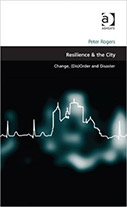Resilience & the City: Change, (Dis)Order and Disaster

Author: Peter Rogers
Publisher: Farnham, Surrey, UK; Burlington, VT: Ashgate, 2012. 211p.
Reviewer: Vania Ceccato | July 2013
The book under review has an ambitiously broad scope to it, insofar as it aspires to provide an overall understanding of a novel reading of social science to both theory and empirical study of the city as a ‘resilient’ phenomenon. Resilience is considered as a process, “the struggle to adapt within complex, interdependent systems in order to survive, to thrive” (p.1). The book seeks to discuss forms of resilience by looking at changes in the urban environment associated with risk, hazards, danger, disaster, (lack of) security, just to name a few. In the urban context, resilience is according to Rogers, ‘the interplay between different forms of thinking, doing and acting to understand the process of change in space and place over time’ (p.5). The author clearly brings some of his own unique scholarly and professional background to the analysis. The author of this book, Peter Rogers, is a lecturer at Macquarie University in Australia. The book reflects his current field of research and teaching, which involves justice and social order, resilience and history.
In order to understand the city of today, Rogers suggests the use of the method of spatial history to develop an understanding of change. Mostly in the first part of the book, Rogers shows the interplay between beliefs, rules and norms as an indication of how order and disorder emerge and can be traced over time. He proposes that “…time is the lens for understanding how change occurs, space is the lens for understanding where it occurs and place is the lens for unpacking the meaning of change for those who experience it” (p.5). In the second part of the book, he extends this theory by going deeper into “features and characteristics of a democratic, entrepreneurial and capitalistic social order, and the challenges to that order that are posed by ecological, technological and human hazards, risks and threats” (p.3). In adopting a framework that focuses on shifts in the perception of change historically, Rogers inevitably produces a somewhat schematic account that to some extent neglects geographical, political and most importantly, economic contexts in which ‘the city’ occurs.
The book reads like a well written theoretical piece of research but misses an important opportunity to show more concrete examples of resilience in contemporary cities. Some of the examples, particularly those discussed in chapters 3 and 4 are perhaps too focused on issues that are relevant to nation-states and therefore rarely reach the urban scale. My own impression—correct or incorrect—is that Roger’s choice of making ‘history’ and ‘change’ central for the analysis of resilience has limited himself to addressing only that work which he thought was important to validate his arguments, while disregarding a huge amount of work from other areas that has a clear empirical contribution to the study of resilience (e.g., from economics, criminology but also engineering and spatial planning). This criticism applies mainly to sections of chapter 6. For instance, there is a fine line between what is acceptable as criminal acts and what can be claimed as legitimate actions, one being a crime and the other a form of resistance, part of the process of social change. Readers of this book, if they find Roger’s claims relevant, could now turn to the complementary research on this field to further enrich their understanding of resilience, and their ongoing challenges in addressing it.
As in most good books, criticisms can only be directed at what is not there, in other words, what still remains to be explored, rather than at what is present in the book. The reader may wonder how many of Roger’s claims can be generalized for the cities around the world. The book may have missed the chance to be relevant to cities that do not belong to the template created by British or typically Western European cities. It is true that the author of the book never claims any degree of generalization; still the reader may wonder whether processes of resilience would look the same in other parts of the globe, such as in those found in cities of the Global South for instance. If ‘resilience is a not a concrete and measure thing’ (p.178), it would be acceptable to know that it is happening when we see one taking place. These comments are not meant as criticisms so much as calls for further research in such areas.
Rogers is surely correct in suggesting that attempts to create ‘security can create disorder,’ and chapters 4 and 6 provide examples of such statement. The reader may also enjoy the chapter that provides examples and arguments on how disaster can stimulate positive growth. The reader may be less convinced with the argument of the need of characterizing some of these processes as being ‘positive’ (in favor of change) and ‘negative’(as resistant to change) but may later agree with the author when he suggests that there are both positive and negative consequences of becoming a more resilient society.
Resilience and the City represents an important advance in our understanding of the nature of changes in urban environments. On balance, it is cause for celebration that Rogers legitimates the case for more attention to the study of resilience as a process, a result of the interplay of thoughts and actions over time. This book deserves a wide readership from academics from different parts of the world, and experts interested in the process of change and social order in cities.
Vania Ceccato is at CEFIN, School of Architecture and the Built Environment, Royal Institute of Technology, Stockholm, Sweden
vania.ceccato@abe.kth.se


